Fortum Bundle
Who Really Controls Fortum?
The ownership structure of a company is a fundamental aspect that dictates its strategic direction and market influence. Fortum, a leading Finnish energy company, presents a compelling case study in how ownership changes can reshape a business. Understanding Fortum SWOT Analysis and its ownership is crucial for anyone seeking to navigate the complexities of the energy sector.
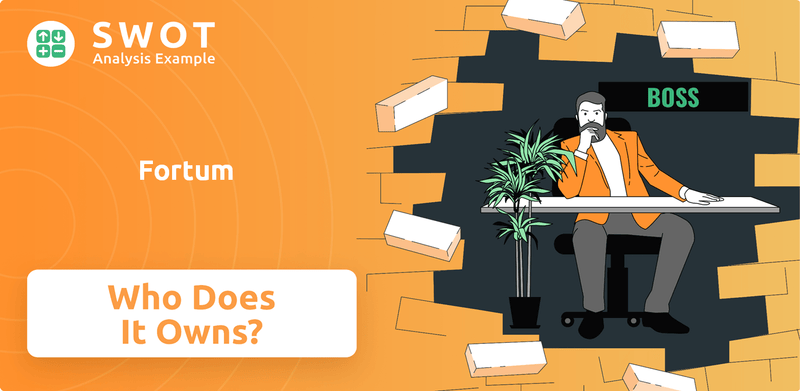
Fortum's story, from its origins as a merger of state-owned entities to its current status, is a testament to the dynamic nature of corporate ownership. This exploration will uncover the intricacies of who owns Fortum, examining its shareholders, its history, and the implications for its future. Discovering the answers to questions like "Who is the CEO of Fortum?" and "Is Fortum a publicly traded company?" will provide valuable insights into this key player in the energy market. This analysis will also delve into Fortum's ownership structure, including its major shareholders, and how these factors influence its strategic decisions and financial performance.
Who Founded Fortum?
The Fortum company was established in 1998, emerging from the merger of Imatran Voima (IVO) and Neste Oy. This union created a significant player in the energy sector. The formation of Fortum marked a pivotal moment in Finland's energy landscape.
Imatran Voima (IVO), a predecessor to Fortum, was founded in 1932 by the Finnish government. Neste Oy, the other key component, was incorporated in 1948, with the State of Finland as a major shareholder. The initial structure of Fortum ownership was heavily influenced by the Finnish government's role.
At its inception in 1998, the Finnish government held a substantial 75.5% stake in Fortum. This significant ownership stake underscored the state's commitment to shaping the company's strategic direction. This initial ownership structure set the stage for Fortum's future as a major national energy provider.
The Finnish government's initial ownership of 75.5% was a key feature.
IVO and Neste Oy were the foundational companies.
Neste's shareholders became Fortum shareholders after the December 1998 IPO.
The state's significant ownership aligned Fortum's objectives with national energy policies.
The founding team's vision, driven by the state, aimed to create a strong national energy player.
Early agreements largely centered around the state's control.
Following the IPO in December 1998, Neste's shareholders also became Fortum shareholders. The initial structure firmly established the Finnish state as the dominant owner. While the exact details of early private equity or angel investors are not detailed in public records, the state's influence was paramount. The vision, driven by the state, was focused on creating a robust national energy entity. For more details on the company's current standing, you can refer to this article about Fortum's ownership structure.
The early ownership of Fortum was heavily influenced by the Finnish government.
- Imatran Voima (IVO) and Neste Oy were the foundational entities.
- The Finnish government held a 75.5% stake at the company's inception.
- Neste's shareholders became Fortum shareholders after the IPO.
- The state's control was aimed at creating a strong national energy player.
Fortum SWOT Analysis
- Complete SWOT Breakdown
- Fully Customizable
- Editable in Excel & Word
- Professional Formatting
- Investor-Ready Format
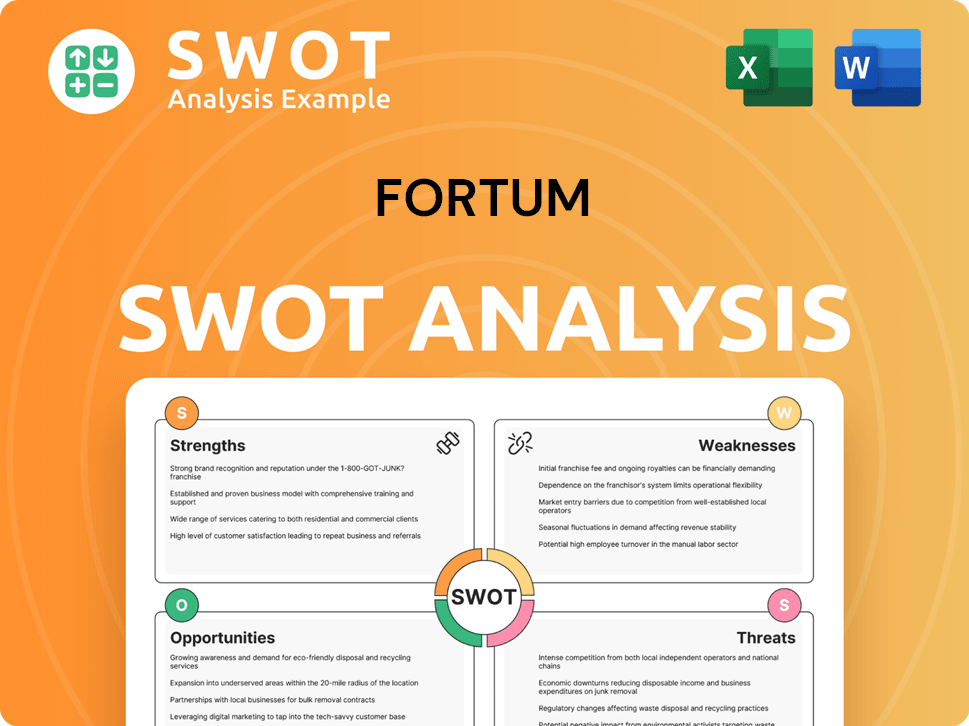
How Has Fortum’s Ownership Changed Over Time?
The evolution of Fortum's ownership has been marked by strategic shifts since its establishment in 1998. Initially listed on the Nasdaq Helsinki stock exchange, the company's ownership has been shaped by investments, divestments, and the enduring influence of the Finnish government. Understanding the dynamics of Fortum ownership is crucial for investors and stakeholders alike, offering insights into the company's strategic direction and financial stability. Key events, such as the Uniper stake acquisition and subsequent divestment, have significantly impacted Fortum's structure.
The Finnish government's role has been pivotal in shaping Fortum's trajectory. As of December 31, 2024, the State of Finland, through the Ownership Steering Department of the Prime Minister's Office, holds a significant stake, representing 51.26% of the shares. This majority ownership provides a stable foundation, aligning Fortum's goals with national energy policies. This has been a consistent feature in Fortum's history, reflecting the government's commitment to the energy sector.
| Event | Date | Impact |
|---|---|---|
| Initial Public Offering | 1998 | Listed on Nasdaq Helsinki. |
| Uniper Stake Acquisition | March 2020 | Increased stake to 69.56%. |
| Uniper Nationalization and Divestment | September 2022 | Sold Uniper shares to the German government. |
Beyond the Finnish government, Fortum shareholders include a diverse group of institutional and individual investors. As of February 6, 2025, individual investors hold approximately 32% of the shares. Institutional investors collectively own around 16%, with key players like Ilmarinen Pension Insurance Co. Ltd. (2.2%) and BlackRock, Inc. (2.1%). Other Finnish national institutions also hold a substantial portion, with a combined 53.03% ownership as of 2023. For further insights into the company's strategic approach, consider exploring the Marketing Strategy of Fortum.
Fortum's ownership structure is a blend of state control and diverse investor participation, ensuring strategic alignment and market responsiveness.
- The Finnish government is the majority owner.
- Individual investors hold a significant portion of shares.
- Institutional investors, including pension funds, are key stakeholders.
- The Uniper divestment reshaped the company's focus.
Fortum PESTLE Analysis
- Covers All 6 PESTLE Categories
- No Research Needed – Save Hours of Work
- Built by Experts, Trusted by Consultants
- Instant Download, Ready to Use
- 100% Editable, Fully Customizable
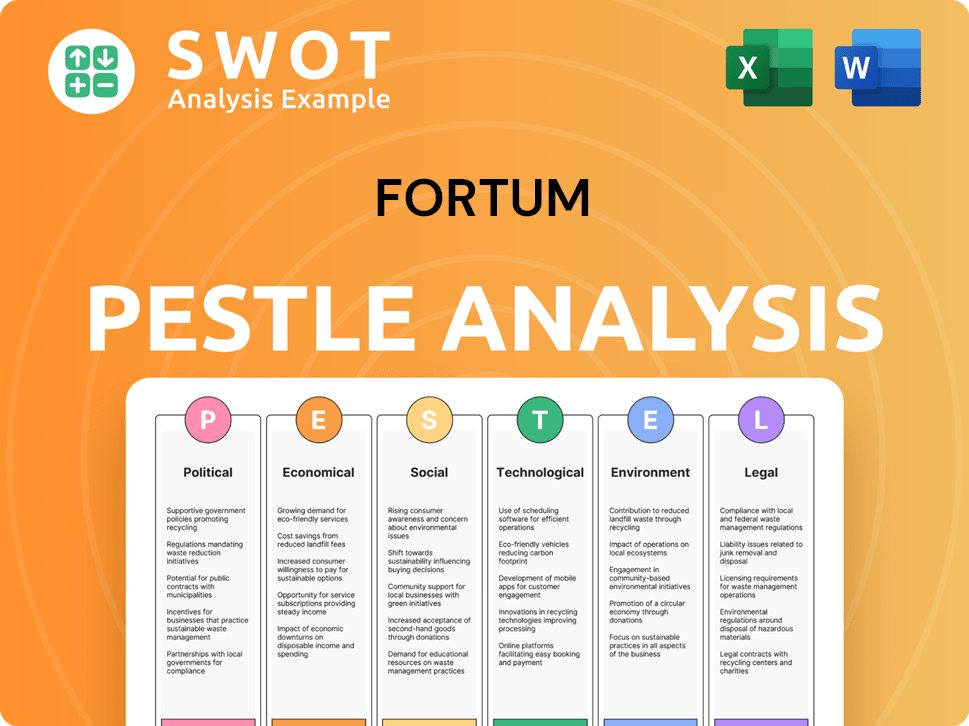
Who Sits on Fortum’s Board?
The corporate governance of the Fortum company adheres to Finnish laws and the company's Articles of Association, fully aligning with the Finnish Corporate Governance Code 2025. The Board of Directors, elected at the Annual General Meeting (AGM) for a one-year term, consists of five to ten members. The AGM also selects the Chair and Deputy Chair of the Board. Understanding Growth Strategy of Fortum provides additional insights into the company's operational framework.
As of the AGM held on March 25, 2024, the Board included Mikael Silvennoinen as Chair, Essimari Kairisto as Deputy Chair, and several other members. All were considered independent of the company and its significant shareholders, except for Maija Strandberg, who represented the State of Finland. For the upcoming AGM on April 1, 2025, the Shareholders' Nomination Board has proposed a board of nine members, with Mikael Silvennoinen and Jonas Gustavsson proposed as Chair and Deputy Chair, respectively.
| Board Member | Role | Independence |
|---|---|---|
| Mikael Silvennoinen | Chair (Proposed) | Independent |
| Jonas Gustavsson | Deputy Chair (Proposed) | Independent |
| Ralf Christian | Member (Proposed) | Independent |
| Luisa Delgado | Member (Proposed) | Independent |
| Marita Niemelä | Member (Proposed) | Independent |
| Teppo Paavola | Member (Proposed) | Independent |
| Johan Söderström | Member (Proposed) | Independent |
| Vesa-Pekka Takala | Member (Proposed) | Independent |
| Stefanie Kesting | Member (Proposed) | Independent |
The State of Finland's majority ownership, at 51.26% as of December 31, 2024, gives it significant control over the company. This substantial stake means that the public, through the state, has considerable influence on Fortum's management and decisions. The Shareholders' Nomination Board, which proposes Board members and their remuneration, includes representatives from major Fortum shareholders, with Maija Strandberg, Director General of the Prime Minister's Office, Ownership Steering Department, as its Chair. This structure ensures the state's interests are strongly represented in Fortum's governance.
The Finnish state's significant ownership of Fortum, at over 51%, gives it major control over the company's strategic direction.
- The Board of Directors is elected annually, with proposed changes for the 2025 AGM.
- The Shareholders' Nomination Board, chaired by a representative from the Prime Minister's Office, ensures state interests are represented.
- All proposed board members are independent of the company and its shareholders.
- Understanding Fortum shareholders and the Fortum ownership structure is crucial for investors.
Fortum Business Model Canvas
- Complete 9-Block Business Model Canvas
- Effortlessly Communicate Your Business Strategy
- Investor-Ready BMC Format
- 100% Editable and Customizable
- Clear and Structured Layout
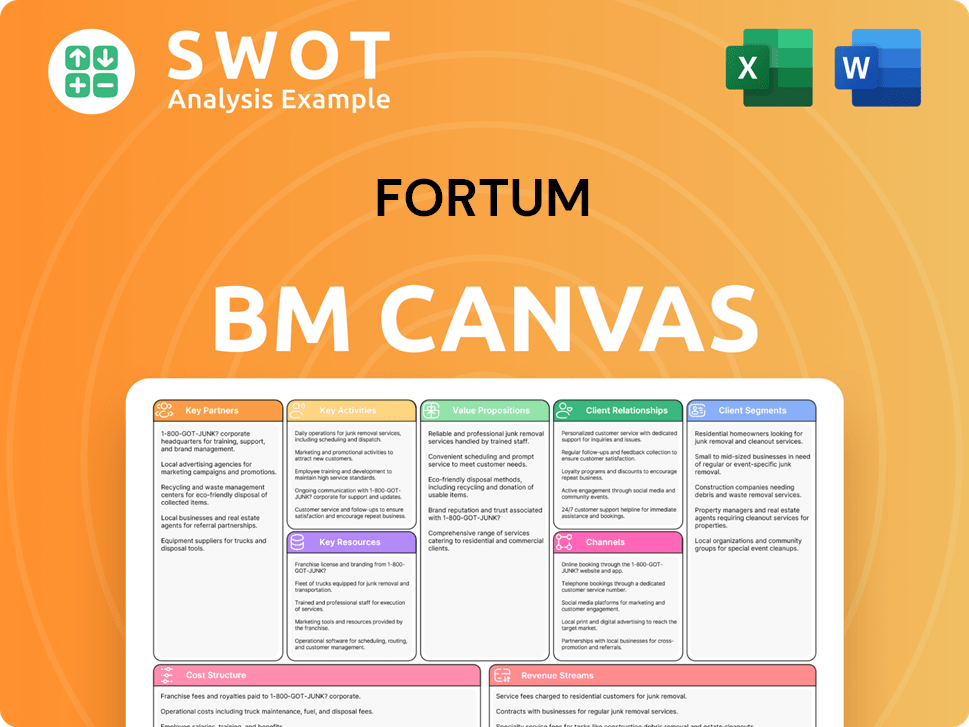
What Recent Changes Have Shaped Fortum’s Ownership Landscape?
Over the past few years, the Fortum company has significantly reshaped its ownership structure. A key move was the complete divestment of Uniper to the German state in September 2022. This strategic decision allowed Fortum to refocus on its core operations, particularly within the Nordic market. This shift highlights a broader trend in the energy sector towards consolidation and a greater emphasis on clean energy sources.
In 2024, Fortum continued to streamline its portfolio by divesting its recycling and waste business, a move expected to reduce its fixed cost base. This transaction, along with the sale of its remaining Indian solar power portfolio in May 2025, underscores Fortum's strategic adjustments. The Finnish government, as the majority owner, influences financial policy, with the Board of Directors proposing a dividend of EUR 1.40 per share for the financial year 2024.
| Key Development | Details | Financial Impact |
|---|---|---|
| Uniper Divestment | Sold entire share package to the German federal government | Recovered approximately €500 million |
| Circular Solutions Divestment | Sold recycling and waste business | Tax-exempt gain of EUR 176 million, net cash flow of approximately EUR 720 million |
| Indian Renewables Exit | Sold remaining solar portfolio | Sales gain of EUR 16 million (Q2 2024) |
The changes in Fortum ownership reflect a strategic pivot toward sustainable energy. Fortum's focus is on efficient low-carbon power generation, customer services, and heating and cooling, with 99% of its power generation from renewable or nuclear sources. This strategic direction is supported by investments, with approximately €1.7 billion in capital expenditure planned for 2024-2026. For a deeper understanding of the company's operations, check out this article about Revenue Streams & Business Model of Fortum.
Fortum divested Uniper, recycling and waste businesses, and its Indian renewables portfolio. These actions streamlined the company's focus on core operations. The divestments also improved its financial position.
The Finnish government is the majority owner, influencing the company's financial strategy. The focus is on stable dividends and investments in core areas. This structure supports the company's long-term goals.
New appointments to the Fortum Leadership Team occurred in late 2024 and early 2025. These changes reflect the company's evolving leadership needs. The new leadership will guide the company's strategic direction.
The company concentrates on efficient low-carbon power generation and customer services. Approximately €1.7 billion is earmarked for capital expenditure. This focus aligns with the broader industry trends.
Fortum Porter's Five Forces Analysis
- Covers All 5 Competitive Forces in Detail
- Structured for Consultants, Students, and Founders
- 100% Editable in Microsoft Word & Excel
- Instant Digital Download – Use Immediately
- Compatible with Mac & PC – Fully Unlocked
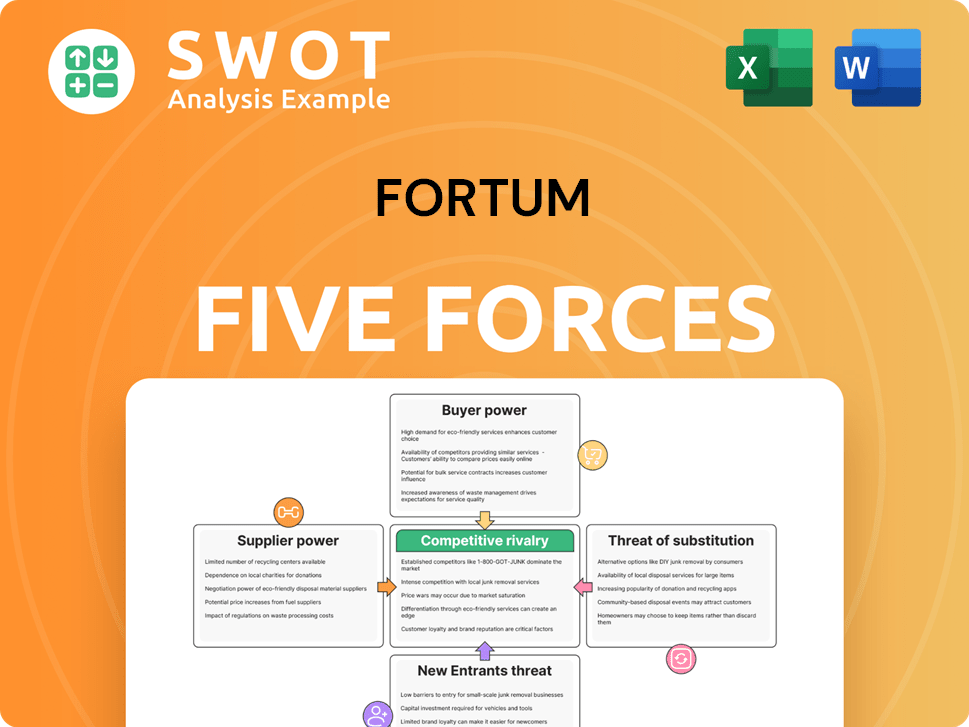
Related Blogs
- What are Mission Vision & Core Values of Fortum Company?
- What is Competitive Landscape of Fortum Company?
- What is Growth Strategy and Future Prospects of Fortum Company?
- How Does Fortum Company Work?
- What is Sales and Marketing Strategy of Fortum Company?
- What is Brief History of Fortum Company?
- What is Customer Demographics and Target Market of Fortum Company?
Disclaimer
All information, articles, and product details provided on this website are for general informational and educational purposes only. We do not claim any ownership over, nor do we intend to infringe upon, any trademarks, copyrights, logos, brand names, or other intellectual property mentioned or depicted on this site. Such intellectual property remains the property of its respective owners, and any references here are made solely for identification or informational purposes, without implying any affiliation, endorsement, or partnership.
We make no representations or warranties, express or implied, regarding the accuracy, completeness, or suitability of any content or products presented. Nothing on this website should be construed as legal, tax, investment, financial, medical, or other professional advice. In addition, no part of this site—including articles or product references—constitutes a solicitation, recommendation, endorsement, advertisement, or offer to buy or sell any securities, franchises, or other financial instruments, particularly in jurisdictions where such activity would be unlawful.
All content is of a general nature and may not address the specific circumstances of any individual or entity. It is not a substitute for professional advice or services. Any actions you take based on the information provided here are strictly at your own risk. You accept full responsibility for any decisions or outcomes arising from your use of this website and agree to release us from any liability in connection with your use of, or reliance upon, the content or products found herein.